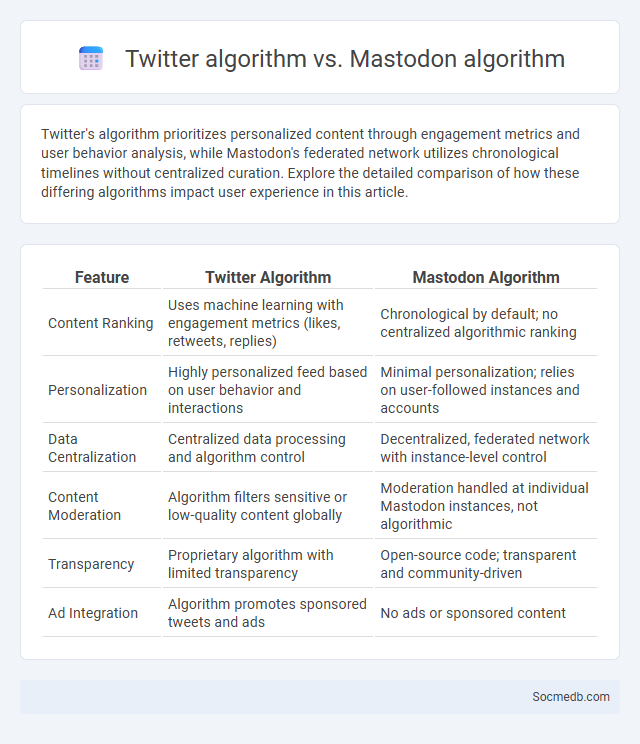
Photo illustration: Twitter algorithm vs Mastodon algorithm
Twitter's algorithm prioritizes personalized content through engagement metrics and user behavior analysis, while Mastodon's federated network utilizes chronological timelines without centralized curation. Explore the detailed comparison of how these differing algorithms impact user experience in this article.
Table of Comparison
| Feature | Twitter Algorithm | Mastodon Algorithm |
|---|---|---|
| Content Ranking | Uses machine learning with engagement metrics (likes, retweets, replies) | Chronological by default; no centralized algorithmic ranking |
| Personalization | Highly personalized feed based on user behavior and interactions | Minimal personalization; relies on user-followed instances and accounts |
| Data Centralization | Centralized data processing and algorithm control | Decentralized, federated network with instance-level control |
| Content Moderation | Algorithm filters sensitive or low-quality content globally | Moderation handled at individual Mastodon instances, not algorithmic |
| Transparency | Proprietary algorithm with limited transparency | Open-source code; transparent and community-driven |
| Ad Integration | Algorithm promotes sponsored tweets and ads | No ads or sponsored content |
Understanding Social Media Algorithms: Twitter vs Mastodon vs Trending
Social media algorithms determine the content you see by analyzing user interactions, engagement patterns, and relevance, with Twitter prioritizing trending topics and personalized feeds, while Mastodon employs a decentralized approach emphasizing chronological order and community-specific content. Trending algorithms highlight popular or viral posts based on real-time user activity and geographic factors, shaping your exposure to emerging conversations and news. Understanding these differences helps optimize your social media strategy for increased visibility and engagement across platforms.
Core Principles Behind Twitter, Mastodon, and Trending Algorithms
Twitter and Mastodon emphasize real-time communication and community-driven content curation, relying on user engagement to prioritize posts. Trending algorithms analyze patterns such as tweet frequency, retweets, and hashtag usage to surface relevant topics dynamically. Your interaction shapes these platforms, influencing what content becomes prominent in your social feed.
How Twitter’s Algorithm Curates Your Feed
Twitter's algorithm curates your feed by prioritizing content based on user interactions such as likes, retweets, and replies, ensuring personalized relevance. It analyzes tweet recency, engagement levels, and media types to surface trending topics and influential accounts tailored to your interests. Machine learning models continuously adapt to shifts in user behavior, optimizing content discovery for enhanced engagement and meaningful connections.
Mastodon’s Decentralized Approach to Content Discovery
Mastodon's decentralized approach to content discovery relies on federated servers, allowing users to explore diverse communities without centralized algorithms dictating visibility. This structure enhances user control over data and mitigates echo chambers by promoting organic content spread across interconnected instances. Leveraging ActivityPub protocol, Mastodon ensures seamless interoperability among platforms, fostering a more open and user-driven social media experience.
What Drives Trending Algorithms Across Platforms?
Trending algorithms across social media platforms are primarily driven by user engagement metrics such as likes, shares, comments, and watch time, which signal content relevance and popularity. Machine learning models analyze these interactions alongside content freshness, user demographics, and network effects to predict and amplify viral posts. Platforms like Twitter, TikTok, and Instagram leverage real-time data and behavioral patterns to dynamically adjust trending topics, ensuring personalized and timely content delivery.
User Experience: Engagement and Personalization Compared
User experience on social media thrives on engagement metrics such as likes, comments, and shares that foster interaction and community building. Personalized content feeds leverage algorithms to tailor posts and ads specifically to your interests, increasing relevance and time spent on the platform. This combination of active participation and customized experiences significantly enhances user satisfaction and platform loyalty.
Transparency and Control: User Influence on Each Algorithm
Social media platforms increasingly prioritize transparency, allowing you to understand how different algorithms curate your feed based on engagement, interests, and behavior data. Your control over settings such as content preferences, ad customization, and privacy options directly influences algorithmic outputs, enhancing relevance and user experience. By actively managing these controls, you shape the visibility and type of content algorithms promote, fostering a more personalized digital environment.
Algorithm Bias and Content Moderation: Platform Differences
Algorithm bias in social media platforms often leads to unequal content visibility, disproportionately affecting marginalized groups and perpetuating stereotypes. Content moderation varies significantly across platforms like Facebook, Twitter, and TikTok, each employing distinct policies and AI tools that impact the removal or promotion of certain types of content. Understanding these differences is crucial for addressing the challenges of fairness, transparency, and user safety in digital communication environments.
Impact on Virality: Hashtags, Trends, and Content Reach
Hashtags amplify your content's visibility by categorizing posts and making them discoverable to broader audiences actively searching or following those tags. Trending topics drive mass engagement, rapidly increasing content reach and encouraging users to participate in viral conversations. Strategic use of hashtags and trends enables your posts to penetrate diverse social media networks, significantly boosting virality and audience interaction.
Future Developments in Social Media Algorithms
Future developments in social media algorithms will increasingly leverage artificial intelligence and machine learning to enhance content personalization, predict user preferences, and improve engagement metrics. These algorithms will prioritize authentic interactions and filter out misleading information, aiming to create a safer and more relevant user experience. Understanding these advancements can help you optimize your content strategy to reach your target audience more effectively.
 socmedb.com
socmedb.com